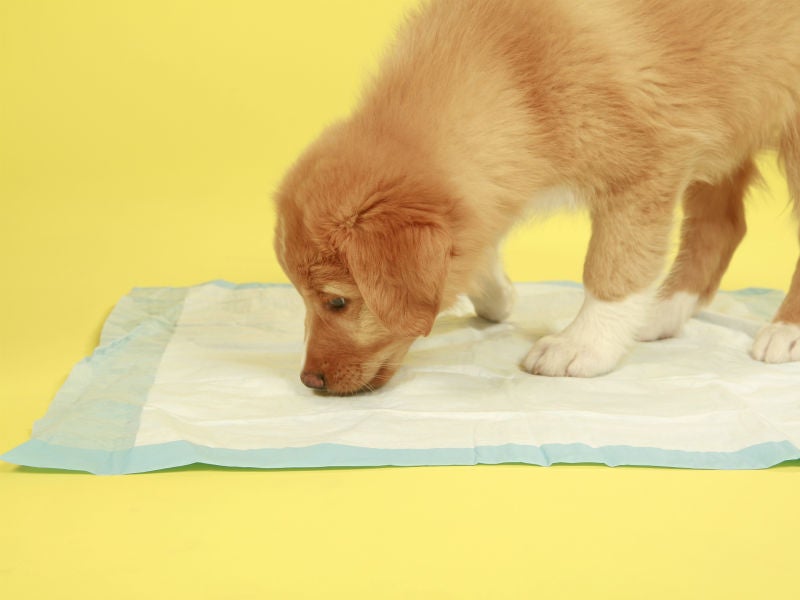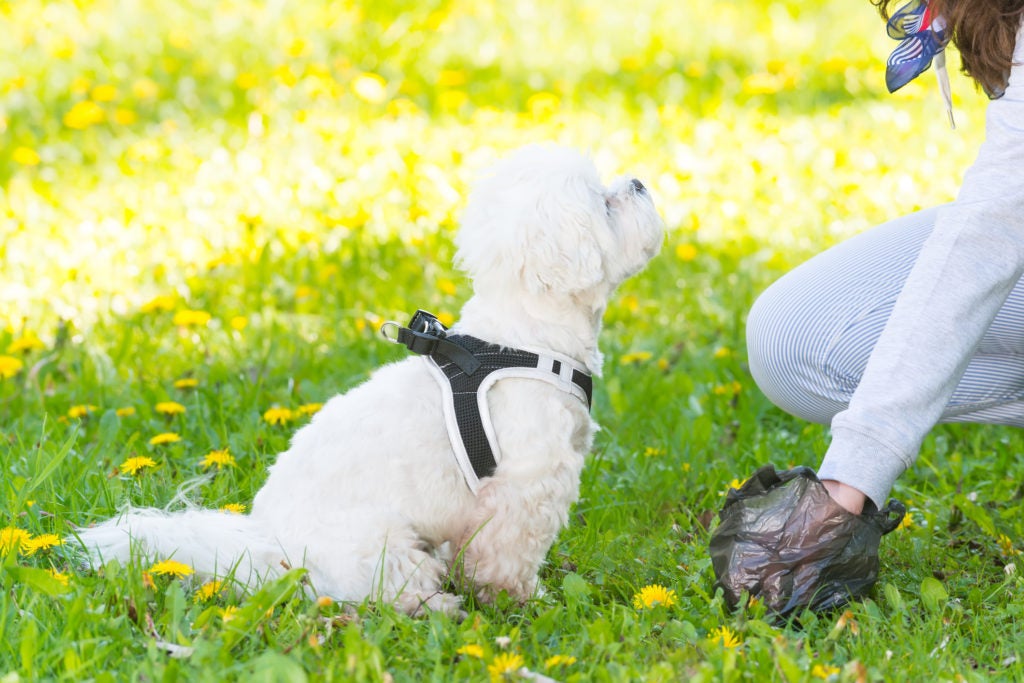How to Get Dog to Use Pee Pad
For all the joy and excitement of bringing home a new puppy, potty training can be enough to make you wonder what you were thinking. In fact, one of the most popular questions on The AKC GoodDog! Helpline is how to potty train a puppy. The goal of potty training is simple, but the details can be confusing, like whether to use puppy pads.
Having your dog go outside is the ideal solution, but potty pads can sometimes play a role in successful potty training. For example, with very young puppies it's necessary to make frequent trips outside. That might be too challenging for elderly owners or apartment dwellers. Or if you don't have a backyard and your dog's toilet area is a public place, you might want to limit your puppy's exposure until he's fully vaccinated. So, if you want to include potty pads in your puppy's housetraining routine, read on for tips on how to potty train a puppy on pads.
Be Patient
It's easy to get frustrated with your new puppy when potty training is taking longer than you expected. But it's essential to be patient during this process. Remember, potty training takes time. Don't expect more from your puppy than he is able to deliver. The following points will help you keep your cool:
In Partnership with 
*Dog friendly rental filter applied to results
- Decide if you will be using disposable or reusable puppy pads
- A puppy can't control his bladder until he is 16 weeks old. So as much as you might like him to wait, he simply can't.
- A puppy can only hold his bladder as long as his age in months plus one hour. So, a four-month-old puppy can only hold it for five hours. That includes during the night as well.
- Every breed is different. For example, a toy breed might need more frequent potty breaks due to a fast metabolism and tiny bladder.
- Every puppy is different, even within breeds. Your first puppy might have been potty trained in a few weeks, but your next one might need months.
Supervise at All Times
It's important to watch your puppy at all times for safety, but this is also the key to successful potty training. You can't prevent accidents if you don't have your eyes on the dog. Here are some tips to help with supervision:
- Take your puppy to the potty pad frequently. How often will depend on his age and bladder strength. For very young puppies, it could be as often as every 15 minutes. Better a wasted trip than an accident.
- Set a timer if you're having trouble remembering when to take your puppy to his pad.
- Watch your puppy for telltale signs he has to go such as sniffing the ground, circling, or whining. When you see those signs, take him straight to the potty pad.
- Use a long leash if you are having trouble keeping your puppy in sight. Tie the leash to heavy furniture or around your waist to limit your puppy's movements.
- Put your puppy in a crate or a safe area whenever you can't supervise him.

Use a Crate
A crate is an important potty training tool because dogs don't like to soil where they sleep. Plus, a strong denning instinct means that if you introduce a crate properly, your puppy will see it as his safe space rather than a punishment. Keep the following in mind when introducing a crate to your puppy:
- Choose an appropriately sized crate. Your puppy should be able to lie down and turn around but with no extra room. If the crate is too large, your puppy can use one end as a toilet which will delay potty training.
- Use dividers with a larger crate. If you buy a crate for your dog's adult size, dividers can help the crate "grow" with your puppy.
- Associate the crate with wonderful things. If you put treats in the crate, feed your puppy at the back of the crate, and leave food-stuffed chew toys in the crate, your puppy will learn to love it.
- Reward your puppy for going in his crate. He will be happy to go inside if it's a rewarding place to be. Although a crate is great for a quiet time out, don't use it for punishment.
- Take your puppy straight to his potty pad whenever you let him out of his crate.
Be Consistent
When thinking about how to potty train a puppy, don't underestimate routine and consistency. Setting a schedule and sticking to it will help prevent accidents and ensure you give your puppy every chance to go in the right location. These tips will help you stay consistent:
- Know when your puppy has to go. Most puppies need the bathroom when they wake up in the morning, after eating, after playing, and after napping. So, take your puppy to the potty pad every time one of these events occurs.
- Take your puppy to the potty pad anytime they haven't been for an hour or two.
- Bring your puppy to the potty pad whenever you suspect it's time. But if he doesn't go, don't let him run around and play. Instead, put him back in his crate for 10-15 minutes, then immediately try again. Repeat until he does his business.
- Feed your puppy on a schedule. If you control when your puppy eats, you can better predict when he'll have to go to the bathroom. Don't free feed.
- Choose an appropriate place for the potty pad. Try not to move it while your puppy is still learning. If you confuse your puppy, he will have more accidents and take longer to train.
Reward With Praise and Treats
Dogs repeat behaviors that are rewarding and doing their business in the right spot is no different. If you reward your puppy with praise and treats whenever he uses his potty pad, he will be more likely to use it again in the future. Keep the following in mind when rewarding your puppy:
- Reward your puppy immediately after he does his business. Don't wait to get the treats out of the cupboard. Have them ready to go in the moment.
- Keep a bowl or bag of treats beside the potty area so you are always prepared.
- Use a leash if your puppy is easily distracted. Walk him to the potty pad on a leash and only unclip him after he's done his business. The freedom to play will be a bonus reward.
Switch From Pads to the Outdoors
When it's time to transition your puppy from potty pads to the outdoors, many of the tips above can be applied in the same way. Simply take your puppy outside rather than to his pad. This advice can help along the way:
- Teach your puppy a potty cue like "Hurry Up" or "Go Potty." Start by using the cue whenever your puppy is about to go, then reward him as soon as he finishes. With enough repetition, you will be able to ask your puppy to go where and when it's convenient for you, including in the outdoor toilet area.
- Move the potty pad outside. Only move it a small distance each day so you don't confuse your puppy. First work toward the door to the outside, then to just outside that door, then slowly to the final outdoor location.
- Decrease the size of the potty pad once it's outside. Some puppies will catch on quickly, particularly with the help of potty cues, but if your puppy is struggling, cut the potty pad smaller and smaller until he's using the ground instead.

Handle Accidents Calmly
It's human nature to look for what's wrong and take what's right for granted. But we need to do the complete opposite with our puppies. Always reward and praise good behavior and ignore the things that go wrong. This is especially true with potty training accidents. Bathroom mistakes are inevitable with puppies, so please don't overreact and frighten or punish your puppy. Here are some tips for handling potty accidents:
- Interrupt your puppy if you catch him in the act of having an accident. Don't scare or startle him. Marking the behavior with a quiet hand clap or the words "oh-oh" should be enough to stop him mid-stream. Punishing him in the act will only teach him not to go in front of you, leading to a dog that sneaks behind the couch to go in private.
- Take your puppy to his potty pad as soon as you catch him. If he stopped when you interrupted him, he might finish on the pad and you can reward him when he does. If he doesn't finish on the pad, at least you have shown him where he should have gone.
- Do nothing if you don't see the accident happen. Showing your puppy after the fact won't teach him anything about potty training. If you want to scold somebody, lecture yourself for not supervising closely enough.
- Clean all accidents with an enzymatic cleaner. Dogs are attracted to the smell of previous business, so thorough and proper cleaning is essential.
AKC is a participant in affiliate advertising programs designed to provide a means for sites to earn advertising fees by advertising and linking to akc.org. If you purchase a product through this article, we may receive a portion of the sale.
Source: https://www.akc.org/expert-advice/training/the-ins-and-outs-of-potty-pad-training/